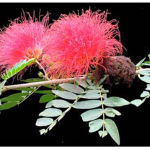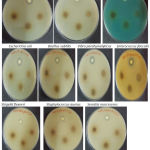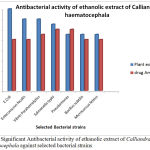Manuscript accepted on :September 08, 2017
Published online on: --
Plagiarism Check: Yes
Glory Josephine I1, Punnagai K2 and Muthiah N. S1
1Department of Pharmacology, Sree Balaji Medical College and Hospital, Chennai, India.
2Department of Pharmacology, Sri Ramachandra Medical College and Research Institute, Chennai, India.
Corresponding Author E-mail: kpunnagai@yahoo.in
DOI : https://dx.doi.org/10.13005/bpj/1230
Abstract
Calliandra haematocephala commonly known as powder puff has wide range of therapeutic properties like anti inflammatory, anticonvulsant, immunomodulatory and blood purifier. Previous Studies showed the antibacterial activity of the flowers and bark of Calliandra haematocephala, So this study is designed to evaluate the antibacterial activity of the ethanolic extract of the leaves of “Calliandra haematocephala“ against selected gram positive and gram negative strains. The leaves of Calliandra haematocephala was subjected to soxhlet extraction using organic solvent of ethanol. The antibacterial activity of Calliandra haematocephala extract was done using standard disc diffusion method using Muller Hinton agar (MHA) against ten strains of bacteria (Three gram positive and Seven gram negative strains). Ampicillin is the standard positive control and 20μl of varying concentrations (1000 μg, 750μg and 500 μg) of the extract sample were tested. The antibacterial effect was determined by measuring the diameter of the zone of inhibition. The ethanolic extract of Calliandra haematocephala showed the moderate antibacterial activity against gram negative bacterial strains like Salmonella typhi (12mm) Serratia marcescens (9mm), Shigella flexneri (8mm) and gram positive bacterial strains like Staphylococcus aureus (9mm), Bacillus subtilis (10mm), Micrococcus leteus (10mm) as measured by the zone of inhibition produced by the plant extract when compared with the control drug Ampicillin. However it showed maximal activity against Pseudomonas aeroginousa (12mm).In our study the ethanolic extract of Calliandra haematocephala has shown to have good antibacterial activity against both gram negative and positive bacteria in high concentration.
Keywords
Antibacterial Activity; Agar Disc Diffusion; Calliandra Haematocephala; Zone of Inhibition
Download this article as:| Copy the following to cite this article: Josephine G. I, Punnagai K, Muthiah N. S. In Vitro Antibacterial Activity of Ethanolic Extract of ‘Calliandra Haematocephala’ Against Selected Bacterial Strains. Biomed Pharmacol J 2017;10(3). |
| Copy the following to cite this URL: Josephine G. I, Punnagai K, Muthiah N. S. In Vitro Antibacterial Activity of Ethanolic Extract of ‘Calliandra Haematocephala’ Against Selected Bacterial Strains. Biomed Pharmacol J 2017;10(3). Available from: http://biomedpharmajournal.org/?p=16624 |
Introduction
Herbals have been used as therapeutic agents for longer period in our Traditional medical system. Considering the emergence of the multidrug resistance, cost and adverse effects of the antibiotics these natural sources provide nice opportunities for new drug leads. Also the therapeutic potential, least side effects and cost draw the researcher’s attention to identify phytochemicals with antibacterial activity that will cure the bacterial infections.
Calliandra haematocephala (family Mimosaceae), is a spreading well-branched shrub growing to a height of 1 to 3 meters. It has silky leaflets which are glossy copper when new, turning to a dark metallic green, The profuse, fragrant bloom is the main reason for its popularity, with big puffs, two to three inches across, of watermelon pink, deep red, or white silky stamens, produced during warm months1
 |
Figure A Click here to View figure |
Native to North America,but it has been grown in Indian garden and park for longer period.Studies shows that Calliandra haematocephala has antiinflammatory,gastroprotective,2 anticonvulsant, immunomodulatory, and antiulcerogenic properties. The decoction of the flower extract is used as blood purifier and tonic everywhere because of its antioxidant property.3 Its roots are used for hemorrhoids.4 It is reported that betulinic acid in calliandra is responsible for its antitumor, anti –HIV5 and anti rotaviral activity6
Traditionally it is used as antibacterial agent7 and studies showed about its antibacterial activity of bark and flowers. One study showed the antibacterial activity of silver nanoparticles synthesized using the leaf extract of Calliandra haematocephala against E. coli. Gallic acid present in the leaf extract plays a major role in synthesis of silver nanoparticles that leads to its antibacterial activity.8 Also fractionation of the bark of Calliandra haematocephala by chromatographic methods identified the compounds p-hydroxybenzoic acid, caffeic acid, protocatechuic acid, astilbin, neo-isoastilbin, and catechin-3-O-rhamnoiside.These compounds showed varied antibacterial activity.7 In another study in vitro investigation of extract obtained from flowers of the shrub Calliandra haematocephala showed greater activity against gram positive bacteria Staphylococcus aureus9 Disc diffusion method is one of the reliable, most commonly used in vitro screening methods to evaluate the antibacterial activity of various drugs and phytochemicals.10
Since the above findings suggested for strong antibacterial activity, we designed this study to prove the antibacterial activity of the ethanolic extract of the leaves of Calliandra haematocephala against selected gram positive and gram negative microorganisms using the in vitro standard disc diffusion method.
Materials and Methods
Plant Materials
The leaves of Calliandra haematocephala were collected in and around area-Madipakkam and certified by Prof. P.Jayaraman, Director, Plant Anatomy Research Centre, West Tambaram.
(Reg no. PARC/2017/3442)
Phytochemical Analysis
The phytochemial analysis shows the presence of alkaloids, tannins, flavonoids, sapponins and glycosides.
Extraction
The leaves of Calliandra haematocephala, cut into pieces, air dried and powdered. 25 gram of powdered sample were taken and extracted with 300ml of ethanol in soxhlet apparatus for 12 hours of time. The crude extract was filtered and the solvents were further condensed using rotary evaporator. The crude extract was stored at room temperature in airtight container for further analysis. A portion of the extract is used for antibacterial evaluation.
Bacterial Culture and Preparation of Inoculum
The bacterial strains used in the study are three specimens of gram positive bacteria (Staphylococcus aureus, Bacillus subtilis and Micrococcus leteus ) and seven gram negative bacteria specimens (Salmonella typhi, , Serratia marcescens, Escherichia coli, Shigella flexneri, Vibro parahymolyticus, Pseudomonas aeroginousa and Enterococcus,) clinical isolates purchased from MTCC, Chandigarh. The isolates were identified by a standard method (Cowan and steel, 1993). Stock cultures were maintained at 4°C on Nutrient agar Slant. Active cultures for experiments were prepared by transferring a loopful of culture from the stock cultures into the test tubes containing nutrient broth , that were incubated at 24hrs at 37ºC. The Assay was performed by agar disc diffusion method. The culture media and the Ampicillin discs were purchased from hi media labs, Mumbai, India.
Bacterial Susceptibility Testing
In vitro Antibacterial activity of extract was determined against three specimens of gram positive bacteria (Staphylococcus aureus, Bacillus subtilis and Micrococcus leteus ) and seven gram negative bacteria specimens (Salmonella typhi, , Serratia marcescens, Escherichia coli, Shigella flexneri, Vibro parahymolyticus, Pseudomonas aeroginousa and Enterococcus,) by agar disc diffusion method on Muller Hinton agar (MHA) medium. Muller Hinton Agar (MHA) medium is poured in to the petriplate. After the medium was solidified, the inoculums were spread on the solid plates with sterile swab moistened with the bacterial suspension. The disc were placed in MHA plates and 20μl of sample (Concentration: 1000μg, 750μg and 500 μg) were placed in the disc .The plates were incubated at 37ºC for 24 hrs.. Then the antimicrobial activity was determined by measuring the diameter of zone of inhibition. The diameter of the zone of inhibition produced by each agent were measured with a transparent ruler in millimeter and compared with those produced by the commercial antibiotic Ampicillin (20μl/disc) served as a positive control. The diameters of the zone of inhibition less than 5mm were considered insignificant for analysis.
Table 1: Antibacterial activity produced by the various concentrations of Calliandra haematocephala ethanolic extract against selected bacterial strains compared with Ampicillin as a positive control
| Organisms | MTCC No. | Zone of inhibition (mm) | Ampicillin (1mg/ml) | ||
| Concentration(μg/ml) | |||||
| 1000 | 750 | 500 | |||
| Salmonella typhi | 1169 | 12 | 11 | 11 | 13 |
| Micrococcus leteus | 7950 | 10 | 10 | 10 | 11 |
| Serratia marcescens | 3124 | 9 | 8 | 7 | 10 |
| Escherichia coli | 45 | 10 | 8 | 7 | 16 |
| Bacillus subtilis | 2763 | 10 | 9 | 7 | 11 |
| Staphylococcus aureus | 3160 | 9 | 8 | 7 | 10 |
| Shigella flexneri | 9543 | 8 | 8 | 8 | 9 |
| Vibrio parahaemolyticus | 451 | 11 | 10 | 8 | 14 |
| Pseudomonas aeroginousa | 2581 | 12 | 12 | 12 | 11 |
| Enterococcus faecalis | 3159 | 10 | 8 | 8 | 14 |
Results
Results showed the antibacterial activity of Calliandra haematocephala leaves on all strains. They were effective against both gram positive and gram negative organisms in various concentrations (500,750 and 1000μg/ml) when compared with Ampicillin (1mg/ml). The antibacterial activity was assessed by measuring the zone of inhibition. The extract showed the maximum activity against Salmonella typhi (12mm), Micrococcus leteus (10mm),Serratia marcescens (9mm), Bacillus subtilis (10mm), Staphylococcus aureus (9mm) and Shigella flexneri (8mm).It showed maximum inhibition in higher dose (1000μg/ml) and moderate inhibition in 750 and 500μg/ml. But irrespective of the concentration, in all the three doses it showed the same level of inhibition against Micrococcus leteus (10mm), Shigella flexneri (8mm) and Pseudomonas aeroginousa (12mm) .The antibacterial activity of this plant extract showed moderate inhibitory activity against gram negative bacteria like Escherichia coli (10mm), Vibrio parahaemolyticus (11mm) and Enterococcus faecalis (10mm) in higher doses. However it showed the maximum activity against Pseudomonas aeroginousa (12mm) than the control drug.
 |
Figure 1: Zone of inhibition of bacterial colonies by different concentrations of Calliandra haematocephala in the Muller Hinton Agar (MHA) medium Click here to View figure |
 |
Figure 2: Significant Antibacterial activity of ethanolic extract of Calliandra haematocephala against selected bacterial strains Click here to View figure |
Discussion
The above results favour the antibacterial activity of Calliandra haematocephala .The phytochemial analysis of the leaf extract shows the presence of alkaloids, tannins, flavonoids, Sapponin and glycosides; It is proved that both flavonoids and tannins possesses greater antimicrobial activities.11-13 Flavonoids are hydroxylated phenolic compounds known to be synthesized by plants in response to microbial infection.11 Three flavonoid aglycones, quercetin, kaempferol, myricetin were isolated and identified from aerial part Calliandra haematocephala and found to have strong antioxidant activities.14,15 Condensed tannins isolated from bark, stems, and leaves of Calliandra haematocephala were evaluated for in vitro antioxidant activities using BTS+ and FRAP methods and proved their stronger antioxidant activities .Tannins has great antibacterial activity by binding with proline rich protein that interfere with protein synthesis.15 Also, antioxidant galloylated glycosides isolated from leaves of Calliandra haematocephala exhibited moderate to strong radical scavenging properties on lipid peroxidation, hydroxyl radical, superoxide anion generation and DPPH radical in comparison with that of quercetin as a positive control in vitro.16 In our study, the ethanolic extract of leaves of Calliandra haematocephala showed antibacterial activity against both gram positive and gram negative strains in all doses. Particularly it was more effective against Pseudomonas aeroginousa and showed moderate activity against Salmonella typhi, Micrococcus leteus, Serratia marcescens, Bacillus subtilis, Staphylococcus aureus, and Shigella flexneri. The presence of flavonoids, tannins and the strong antioxidant activity could be the reason for the antibacterial activity. Also previous studies showed the antibacterial activity of flowers and bark of Calliandra haematocephala and identified the compounds responsible for that.7,9 So that strongly suggested the antibacterial potential of the leaves of Calliandra haematocephala and its therapeutic role in life threatening microbes. But we need further studies to evaluate the mechanism of action and extraction of phytochemicals that is responsible for its antibacterial activity. Nowadays hospital acquired infections17 is a major threat and particularly multidrug resistant Pseudomonas aeroginousa can be deadly for patients in critical care,18 Since the above results showed maximum activity against Pseudomonas aeroginousa and moderate activity against gram negative organisms ,it could enhance the effectiveness of the antibiotics in life threatening infections.
Conclusion
So the above study proved the antibacterial activity of the ethanolic extract of Calliandra haematocephala leaves against both gram positive and gram negative bacteria and its promising adjuvant role in life threatening hospital acquired infections.
Conflict of Interest
The authors declare that they have no conflict of interest
References
- Kirtikar K. R., Basu B. D. Indian medicinal plants. Periodical Experts book agency. 1998;3:59.
- de Paula A., Barbosa B., da silva P., Parente J. P . Evaluation of gastroprotective activity of. Calliandra haematocephala Planta med. 2012;78:448.
CrossRef - Gupta R., Sharma P., Garg A., Soni A., Sahu A.,et al. Formulation and Evaluation of herbal effervescent granules incorporated with Calliandra haematocephala leaves extract. Indo American Journal of Pharmaceutical Research. 2013;3(6):4366-4371.
- Soladoye O. M., Adetayo M. O., Chukwuma C. E and Adetunj N. A. Ethnobotanical survey of plants used in the treatment of Haemorrhoids in South-western Nigeria. Annals of Biological research. 2010; 1(4):1-15.
- Kasiwada Y., Hashimoto F., Cosentino L. M., Chen C. H., Garrett P. E., et al. Betulinic acid and dihydro betulinic acid derivatives as potent anti HIV agents. J Med chem. 1996;39:1016-1017.
CrossRef - Shaheen M., Mustafa S., El- Esnawy N. Anti rota viral effects of Calliandra haematocephala leaf extracts In- vitro and In- vivo. J Virol Antivir Res. 2015;4(2):1-7.
CrossRef - Nia R., Adesanya S. A., Okeke I. N., Illoh H. C., Adesina S. K. Antibacterial constituents of Calliandra haematocephala. Nig J Nat Prod and Med. 1999;3:58-60.
CrossRef - Raja S., Ramesh V., Thivaharan V. Green biosynthesis of silver nanoparticles of Calliandra haematocephala leaf extract,their antibacterial activity and hydrogen peroxide sensing capability. Arabian Journal of Chemistry. 2017;10:253-261.
CrossRef - Tiwari J and Dr. Raj G. In vitro investigation of anti-microbial and antihelmintic activity of extract obtained from flowers of the shrub Calliandra haematocephala. Journal of Medicinal Plant Studies. 2016;4(4):192-195.
- Bauer A. W., Kirby W. M., Sherris J. C et al. Antibiotic susceptibity testing by a standardized single disc method. American Journal of Clinical Pathology. 1966;45:493-496.
- CrossRef
- Cowan M. M. Plant product as antimicrobial agents. Clinical Microbiology Reviews. 1999;12(4): 564-582
CrossRef - Tsuchiya H., Sato M., Miyazaki T et al. Comparative study on the antibacterial activity of phytochemical flavanones against methicillin-resistant Staphylococcus aureus. Journal of Ethnopharmacology. 1996;50(1):27-34.
CrossRef - Akiyama H., Fujii K., Yamasaki O., Oono T and Iwatsuki K. Antibacterial action of several tannins against Staphylococcus aureus. Journal of Antimicrobial Chemotherapy. 2001;48(4):487-491.
CrossRef - Zeid A. A., Hiffnawy M., Saleh M., Sleem A., Mohamed R et al. Flavonoids, Volatiles and biological activities of the aerial parts of the. Calliandra haematocephala Hassk. Planta Med. 2006;72:335.
CrossRef - Wei S., chen H and Lin Y. Comparison of Chemical Compositions and Antioxidant activities of Condensed Tannins from different parts of Calliandra Haematocephala. Journal of Wood Chemistry and Technology. 2015;35(3):193-206.
CrossRef - Moharram F. A et al. Antioxidant galloylated flavonol glycosides from Calliandra haematocephala. Natural Product Research. 2006;20:927-934.
CrossRef - Anton Y., Peleg and Hooper C. D. Hospital- Acquired infections due to gram- negative bacteria. New Eng J Med. 2010;362:1804-1813.
CrossRef - Hirsch B. E and Tam H. V. Impact of multidrug –resistant Pseudomonas Aeruginosa on patient outcomes. Expert Review Pharmacoecon Outcomes.Res. 2010;10(4):441-451.
CrossRef







